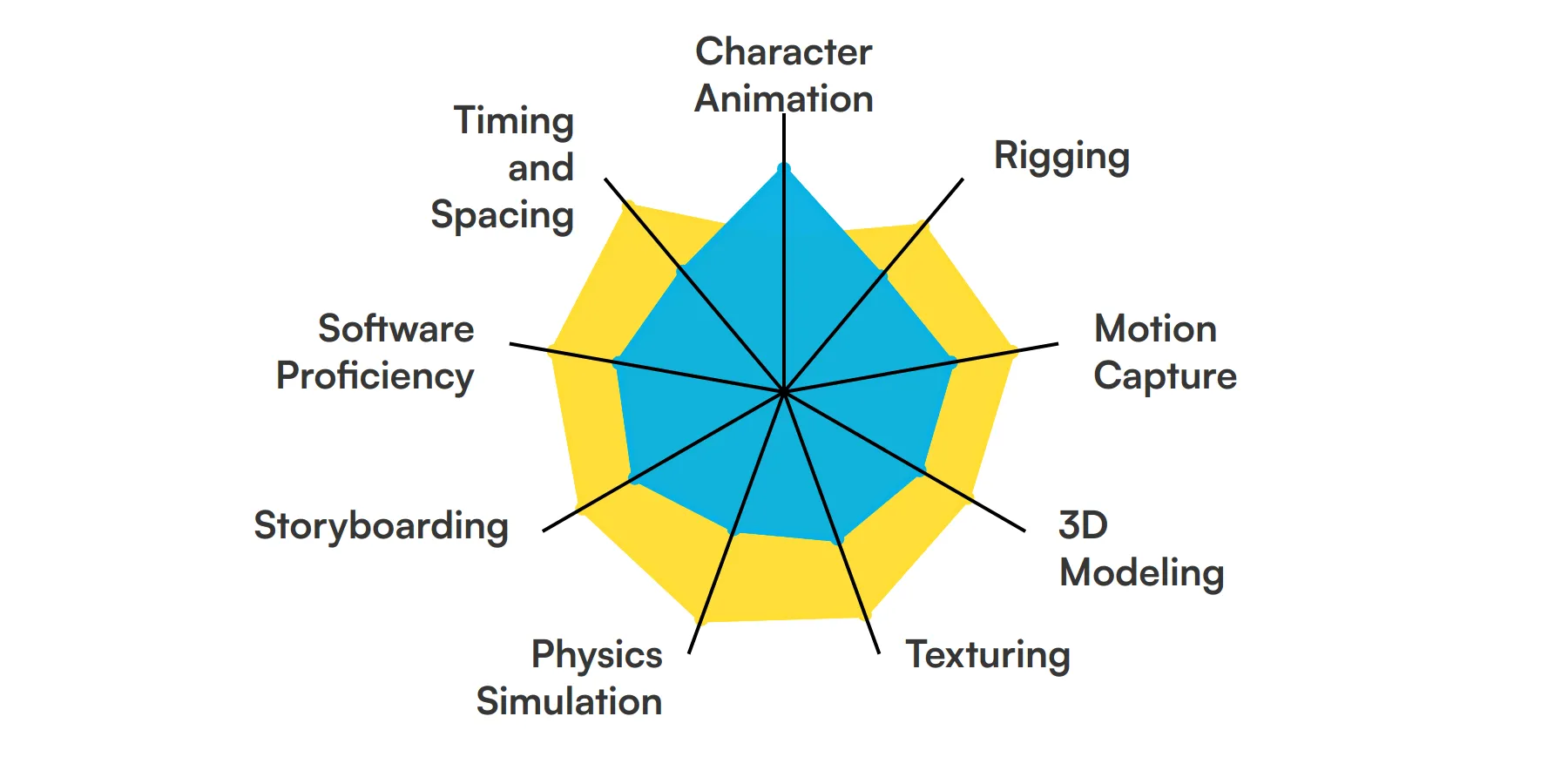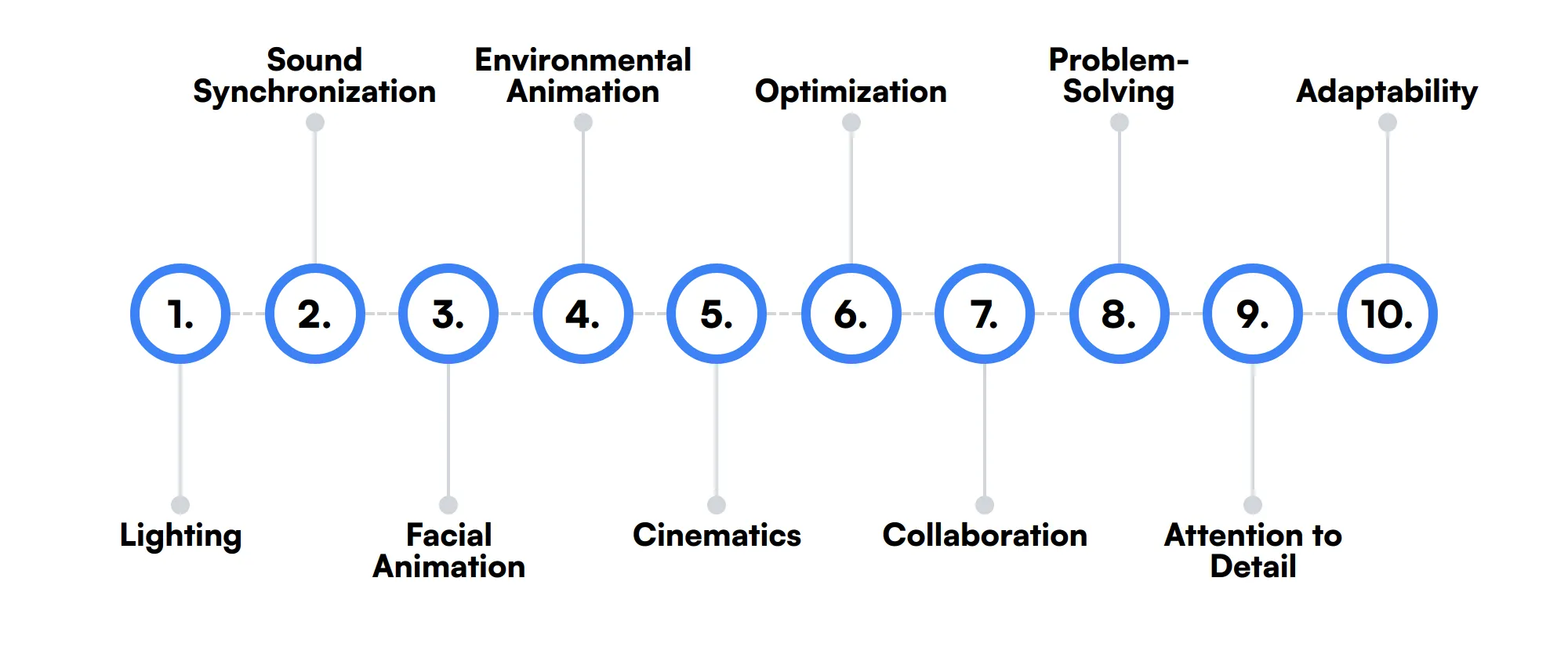Game animators bring characters and environments to life, creating the movement and expressions that make games engaging and immersive. They work closely with game designers and developers to ensure that animations are smooth and enhance the overall gameplay experience.
Skills for game animators include proficiency in animation software like Maya or Blender, a strong understanding of motion and timing, and the ability to work collaboratively within a team. Assessing these skills involves reviewing portfolios, conducting practical tests, and evaluating their ability to communicate and take feedback.
Candidates can write these abilities in their resumes, but you can’t verify them without on-the-job Game Animator skill tests.
In this post, we will explore 9 essential Game Animator skills, 10 secondary skills and how to assess them so you can make informed hiring decisions.
Table of contents
9 fundamental Game Animator skills and traits
The best skills for Game Animators include Character Animation, Rigging, Motion Capture, 3D Modeling, Texturing, Physics Simulation, Storyboarding, Software Proficiency and Timing and Spacing.
Let’s dive into the details by examining the 9 essential skills of a Game Animator.

Character Animation
Character animation involves bringing digital characters to life through movement. Game animators use this skill to create realistic and engaging character actions, ensuring that each movement aligns with the game's narrative and style.
For more insights, check out our guide to writing a Game Animator Job Description.
Rigging
Rigging is the process of creating the bone structure of a 3D model so it can move. Game animators need to understand rigging to ensure that characters and objects can be animated smoothly and realistically.
Motion Capture
Motion capture involves recording the movement of objects or people to use in animation. Game animators use this technology to create more lifelike animations by capturing real-world movements and applying them to digital characters.
3D Modeling
3D modeling is the creation of a three-dimensional representation of any object or surface. Game animators often need to create or modify models to ensure they animate correctly within the game environment.
Texturing
Texturing involves adding surface details to a 3D model. Game animators use texturing to enhance the visual appeal of characters and environments, making them more immersive and realistic.
Physics Simulation
Physics simulation is the use of algorithms to mimic real-world physics in a digital environment. Game animators use this skill to ensure that movements and interactions within the game world follow the laws of physics, adding to the realism.
Storyboarding
Storyboarding is the process of planning out the animation sequence through sketches. Game animators use storyboarding to visualize and organize the flow of animations, ensuring a coherent and engaging narrative.
Software Proficiency
Software proficiency refers to the ability to use animation software like Maya, Blender, or 3ds Max. Game animators must be adept at these tools to create, edit, and refine animations efficiently.
Timing and Spacing
Timing and spacing are fundamental principles of animation that dictate the speed and rhythm of movements. Game animators use these principles to create believable and dynamic animations that enhance the gaming experience.
10 secondary Game Animator skills and traits
The best skills for Game Animators include Lighting, Sound Synchronization, Facial Animation, Environmental Animation, Cinematics, Optimization, Collaboration, Problem-Solving, Attention to Detail and Adaptability.
Let’s dive into the details by examining the 10 secondary skills of a Game Animator.

Lighting
Lighting involves setting up light sources to enhance the mood and realism of a scene. While primarily a task for lighting artists, game animators need a basic understanding to ensure their animations look good under various lighting conditions.
Sound Synchronization
Sound synchronization is the alignment of audio with visual elements. Game animators often work with sound designers to ensure that animations match sound effects and dialogue, creating a cohesive experience.
Facial Animation
Facial animation focuses on animating the expressions and movements of a character's face. This skill is crucial for conveying emotions and enhancing character interactions within the game.
Environmental Animation
Environmental animation involves animating elements within the game world, such as trees swaying or water flowing. Game animators use this skill to make the game environment feel alive and dynamic.
Cinematics
Cinematics are the animated sequences that tell parts of the game's story. Game animators create these sequences to provide context, develop characters, and enhance the overall narrative.
Optimization
Optimization involves refining animations to ensure they run smoothly on various hardware. Game animators need to balance visual quality with performance to provide a seamless gaming experience.
Collaboration
Collaboration is the ability to work effectively with other team members, such as designers, programmers, and artists. Game animators often need to coordinate with others to ensure their animations fit seamlessly into the game.
Problem-Solving
Problem-solving is the ability to identify and resolve issues that arise during the animation process. Game animators frequently encounter technical challenges that require creative solutions to maintain the quality of their work.
Attention to Detail
Attention to detail is crucial for ensuring that animations are polished and free of errors. Game animators must meticulously review their work to catch and correct any issues that could detract from the player's experience.
Adaptability
Adaptability is the ability to adjust to new tools, techniques, and feedback. Game animators need to stay current with industry trends and be open to learning new methods to improve their craft.
How to assess Game Animator skills and traits
Assessing the skills and traits of a game animator involves more than just glancing at a portfolio or resume. It requires a deep dive into their technical abilities and creative finesse across various domains such as Character Animation, Rigging, and Motion Capture, among others.
While traditional hiring methods rely heavily on subjective assessments, modern approaches like skills-based hiring offer a more objective and precise evaluation. For instance, using specialized assessments can illuminate a candidate's practical skills in areas like 3D Modeling, Texturing, and Physics Simulation, which are often hard to gauge through interviews alone.
Incorporating tools like Adaface assessments into the hiring process can significantly streamline the evaluation of a game animator's proficiency in essential software and technical skills. These assessments are designed to mimic real-world tasks that animators face, ensuring that candidates are tested on relevant skills that directly translate to on-the-job performance. By adopting such tools, companies have reported an 85% reduction in screening time, making the hiring process more efficient and effective.
Let’s look at how to assess Game Animator skills with these 5 talent assessments.
CSS
Our CSS test assesses proficiency in using CSS selectors, properties, and values to manipulate the appearance of web pages.
The test assesses their understanding of syntax, selectors, and event handling. Candidates must demonstrate their ability to style web pages, manage layouts, and ensure cross-browser compatibility.
Successful candidates have an expert understanding of CSS layout techniques, responsiveness, and browser compatibility.
JavaScript
Our JavaScript test gauges a vital front end dev skill.
The test challenges a candidate’s knowledge of core JavaScript concepts, such as variables, data types, operators, control flow, and functions. It also assesses their ability to dynamically work with the DOM to manipulate web page elements.
We offer a selection of JavaScript tests, including debugging and data structuring, so you can gauge various skill levels.
React
The React test assesses a candidate’s skills in React, a popular JavaScript library for building user interfaces. This ability is important to evaluate because it’s one of the most commonly used web frameworks, with 40% of developers using it.
This test includes questions on React components, state management, JSX syntax, and lifecycle methods. It also gauges developers’ proficiency in working with React Router for routing and navigation and their ability to handle data flow using props and state.
High-scoring candidates also show expert learning agility. Front end skills like problem-solving directly relate to continuous and quick learning.
jQuery
With our jQuery test, you can evaluate candidates’ knowledge of this common JavaScript library and how quickly they can produce efficient code.
The test evaluates their ability to manipulate and animate web page elements and their knowledge of jQuery plugins and AJAX techniques for dynamic content loading.
Candidates must demonstrate their ability to use jQuery to enhance user interactions and improve the overall user experience on web pages.
SQLite Coding
Our SQLite Coding test discovers intermediate SQL database skills. It assesses a candidate’s ability to create a query on a database with medium complexity.
This test requires the candidate to navigate through a realistic scenario involving a database. Your front end expert must sort the data and exclude irrelevant entries cleanly and quickly. The goal is to build a query that successfully retrieves or changes the information in the database.
Candidates must demonstrate their ability to write efficient SQL queries, manage database schemas, and handle data manipulation tasks.
Summary: The 9 key Game Animator skills and how to test for them
| Game Animator skill | How to assess them |
|---|---|
| 1. Character Animation | Evaluate the animator's ability to bring characters to life realistically. |
| 2. Rigging | Assess skills in creating and managing skeletons for character movement. |
| 3. Motion Capture | Review proficiency in capturing and integrating real-world motion into animation. |
| 4. 3D Modeling | Check the ability to create detailed, accurate three-dimensional models. |
| 5. Texturing | Observe skills in applying surface textures to 3D models effectively. |
| 6. Physics Simulation | Test understanding of real-world physics in animation scenarios. |
| 7. Storyboarding | Examine ability to visualize and layout scenes sequentially. |
| 8. Software Proficiency | Verify familiarity and skill with industry-standard animation tools. |
| 9. Timing and Spacing | Assess understanding of animation principles to convey motion. |
C Online Test
Game Animator skills FAQs
What are the key skills to look for in a game animator?
Game animators should excel in character animation, rigging, and motion capture. Proficiency in 3D modeling, texturing, and physics simulation is also important. Additionally, skills in storyboarding, software proficiency, and timing and spacing are valuable.
How can I assess a candidate's character animation skills?
Review their portfolio for examples of character animation. Look for fluidity, expressiveness, and how well the animations convey emotion and personality. Consider asking them to complete a short animation test.
What software should a game animator be proficient in?
Game animators should be familiar with software like Maya, Blender, and 3ds Max for animation and modeling. Knowledge of Unity or Unreal Engine for game integration is also beneficial.
How important is collaboration in a game animator role?
Collaboration is crucial as animators work closely with designers, programmers, and artists. Assess their ability to communicate ideas and integrate feedback from team members.
What is the role of motion capture in game animation?
Motion capture is used to create realistic animations by recording live actors' movements. Assess candidates' experience with motion capture technology and their ability to refine captured data.
How can I evaluate a candidate's problem-solving skills?
Discuss past projects where they faced animation challenges. Ask how they approached and resolved issues, focusing on their creativity and adaptability in finding solutions.
Why is attention to detail important in game animation?
Attention to detail ensures animations are polished and believable. Look for candidates who can spot and correct subtle errors in timing, spacing, and character movement.
How do you assess a game animator's adaptability?
Evaluate their ability to learn new tools and techniques. Discuss how they've adapted to changes in project scope or technology in past roles.

40 min skill tests.
No trick questions.
Accurate shortlisting.
We make it easy for you to find the best candidates in your pipeline with a 40 min skills test.
Try for freeRelated posts
Free resources



